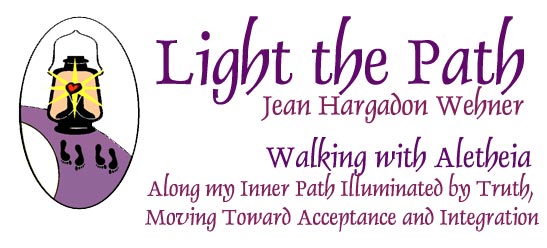Walking with Aletheia: a survivor’s memoir
by Jean Wehner
Eligio Stephen Gallegos, PhD
The manuscript arrived unbidden. Sent to me at the recommendation of a former student and current friend. I was unaware that a public documentary had preceded the writing.
The directness and clarity of the author, Jean Wehner, impressed me immediately. As her story unfolded the gradual recognition of extensive sexual abuse and sadism at the hands of a supposedly religious leader was shocking. The person who professed to be most holy turned out to be most vicious and deceptive. Rather than a man walking a sacred path he had obviously chosen evil as his guide. And evil against children. The worst evil there is.
But the steadfast search for truth, healing, and integration of the victim and author, touched me most deeply.
A tender young girl, just entering onto her path of aliveness in the world, was shattered into many pieces at the hands of someone she had been taught to trust. The shock and horror were unbelievable. Trust was gone. Truth was called into question. Reality lost some of its mooring.
But each of these fragments had its own integrity, its own wholeness. As if a giant caring hand reaching up took away each tragic injury, holding them until the girl had matured enough to be capable of enduring the experience, and then returning them one by one. The Search undertaken by the author is strong and powerful. As she meets each fragment she recognizes its tenacity. She realizes it has endured in its hiding place only so that it could return later, when the threat had passed. But she had to be willing to meet them and participate in healing them together back into her own greater wholeness. Her persistence in this process of becoming whole, informs us of a deep wisdom, the persistence of aliveness itself, in growing us into our full maturity. In trusting this path, the way of her own integrity, she discovers it step by step. The true depiction of her own trust is displayed by her intention: If her writings can help another person to heal she is willing to display her path and show her human injuries and vulnerability.
Fortunately, she is held solidly in love by her husband, Mike, and by her family. And she had an excellent therapist. Opposed to this the unsupporting culture, church and legal system is almost unbearable.
But her trust in her inner guides, those deeper layers of her knowing, a realm that is too easily sidelined into a denigrated ‘imagination’ by much of current society, were uncovered, discovered; were in fact the supportive guides of her experience. First the children she had been, fixated each in its own age by the shock of what it had experienced, knew how to lead her back. Secondly, the appearance of the animals of her deep imagination, returning her to the various qualities of her deep original aliveness and power, provided the belonging in the world that had been sacrificed. She is determined to regain her wholeness. The focus however is not on herself, but on the passionate caring that she feels for each injured part of herself. And on the person who first offered her help, Sister Cathy.
Each part of who she is is whole. Her job, in this womb we call ‘the present’, is to help all of these various parts enter into a relationship with her and with each other. That is the basis of her wholeness. But she cannot demand that they return. She is counselled by her therapist not to go ‘deep sea diving’. They have been hidden for her own survival and they have the wisdom to return when she is ready for the healing. Through her integrity she returns to her own integration. The parts know that wholeness awaits her. But she must choose truth. Which she so beautifully does.
Her path does not involve following a map. It is her inner experiences, preserved and awaiting her return, whose discovery lead her into maturity and healing. The injured children, herself, in partnership, weave the beauty of her Being into the fabric of her mature and caring self.
In Deep Respect,

Eligio Stephen Gallegos, PhD, Psychologist
Author, Inner Journeys: Visualization in Growth and Therapy (1984); The Personal Totem Pole Process (1987); Into Wholeness, The Path of Deep Imagery (2018) and Animals of the Four Windows: Integrating Thinking, Sensing, Feeling and Imagery (2020).
